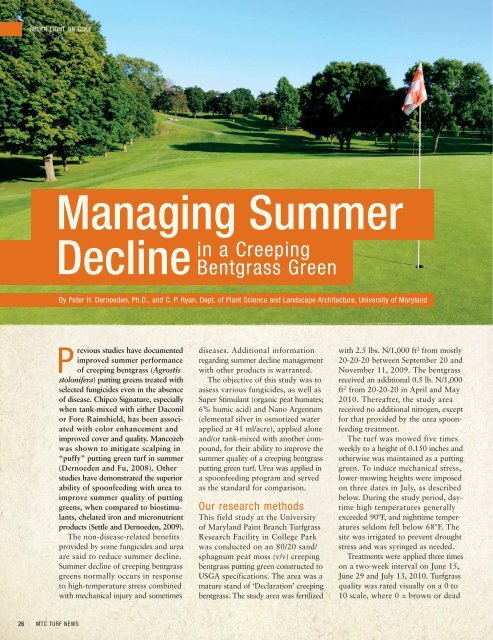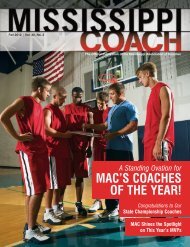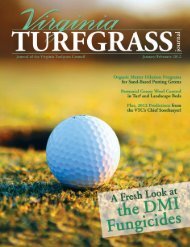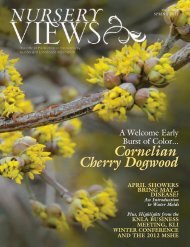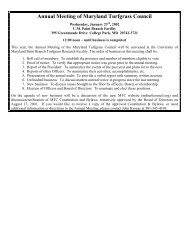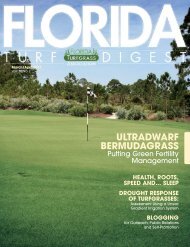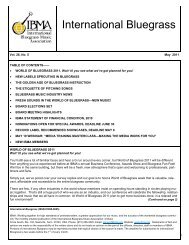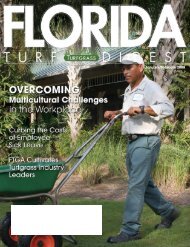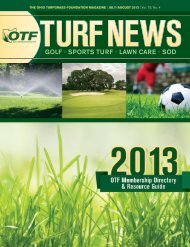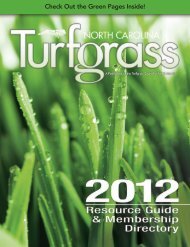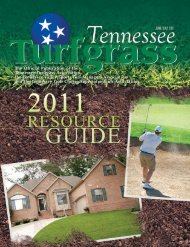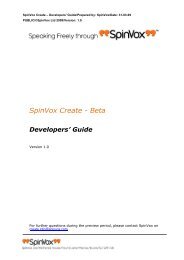the Fate of Field Paspalum Control - The Paginator
the Fate of Field Paspalum Control - The Paginator
the Fate of Field Paspalum Control - The Paginator
You also want an ePaper? Increase the reach of your titles
YUMPU automatically turns print PDFs into web optimized ePapers that Google loves.
GREEN LIGHT ON GOLF<br />
Managing Summer<br />
Decline<br />
in a Creeping<br />
Bentgrass Green<br />
By Peter H. Dernoeden, Ph.D., and C. P. Ryan, Dept. <strong>of</strong> Plant Science and Landscape Architecture, University <strong>of</strong> Maryland<br />
Previous studies have documented<br />
improved summer performance<br />
<strong>of</strong> creeping bentgrass (Agrostis<br />
stolonifera) putting greens treated with<br />
selected fungicides even in <strong>the</strong> absence<br />
<strong>of</strong> disease. Chipco Signature, especially<br />
when tank-mixed with ei<strong>the</strong>r Daconil<br />
or Fore Rainshield, has been associated<br />
with color enhancement and<br />
improved cover and quality. Mancozeb<br />
was shown to mitigate scalping in<br />
“puffy” putting green turf in summer<br />
(Dernoeden and Fu, 2008). O<strong>the</strong>r<br />
studies have demonstrated <strong>the</strong> superior<br />
ability <strong>of</strong> spoonfeeding with urea to<br />
improve summer quality <strong>of</strong> putting<br />
greens, when compared to biostimulants,<br />
chelated iron and micronutrient<br />
products (Settle and Dernoeden, 2009).<br />
<strong>The</strong> non-disease-related benefits<br />
provided by some fungicides and urea<br />
are said to reduce summer decline.<br />
Summer decline <strong>of</strong> creeping bentgrass<br />
greens normally occurs in response<br />
to high-temperature stress combined<br />
with mechanical injury and sometimes<br />
diseases. Additional information<br />
regarding summer decline management<br />
with o<strong>the</strong>r products is warranted.<br />
<strong>The</strong> objective <strong>of</strong> this study was to<br />
assess various fungicides, as well as<br />
Super Stimulant (organic peat humates;<br />
6% humic acid) and Nano Argentum<br />
(elemental silver in osmotized water<br />
applied at 41 ml/acre), applied alone<br />
and/or tank-mixed with ano<strong>the</strong>r compound,<br />
for <strong>the</strong>ir ability to improve <strong>the</strong><br />
summer quality <strong>of</strong> a creeping bentgrass<br />
putting green turf. Urea was applied in<br />
a spoonfeeding program and served<br />
as <strong>the</strong> standard for comparison.<br />
Our research methods<br />
This field study at <strong>the</strong> University<br />
<strong>of</strong> Maryland Paint Branch Turfgrass<br />
Research Facility in College Park<br />
was conducted on an 80/20 sand/<br />
sphagnum peat moss (v/v) creeping<br />
bentgrass putting green constructed to<br />
USGA specifications. <strong>The</strong> area was a<br />
mature stand <strong>of</strong> ‘Declaration’ creeping<br />
bentgrass. <strong>The</strong> study area was fertilized<br />
with 2.5 lbs. N/1,000 ft 2 from mostly<br />
20-20-20 between September 20 and<br />
November 11, 2009. <strong>The</strong> bentgrass<br />
received an additional 0.5 lb. N/1,000<br />
ft 2 from 20-20-20 in April and May<br />
2010. <strong>The</strong>reafter, <strong>the</strong> study area<br />
received no additional nitrogen, except<br />
for that provided by <strong>the</strong> urea spoonfeeding<br />
treatment.<br />
<strong>The</strong> turf was mowed five times<br />
weekly to a height <strong>of</strong> 0.150 inches and<br />
o<strong>the</strong>rwise was maintained as a putting<br />
green. To induce mechanical stress,<br />
lower mowing heights were imposed<br />
on three dates in July, as described<br />
below. During <strong>the</strong> study period, daytime<br />
high temperatures generally<br />
exceeded 90ºF, and nighttime temperatures<br />
seldom fell below 68ºF. <strong>The</strong><br />
site was irrigated to prevent drought<br />
stress and was syringed as needed.<br />
Treatments were applied three times<br />
on a two-week interval on June 15,<br />
June 29 and July 13, 2010. Turfgrass<br />
quality was rated visually on a 0 to<br />
10 scale, where 0 = brown or dead<br />
26 MTC TURF NEWS


